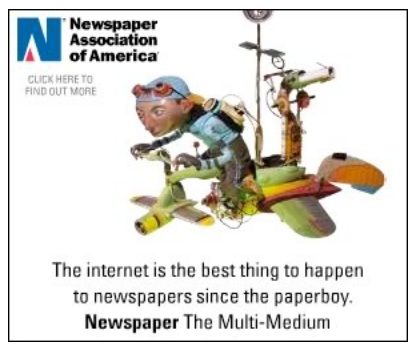The New York Times Co. shows signs of managing through the crisis, although its regional properties continue to drag down overall performance. The company’s earnings fell by almost 50% in the quarter just reported, but when you factor out the cost of layoffs and buyouts, profits were off only about 12%, from 29 to 26 cents per share. That beat analyst expectations. Circulation revenues were up as the company implemented a price increase at its flagship. The company’s regional holdings continue to drag on performance. Combined revenues at The New York Times and the International Herald Tribune were off 9.5%, which is better than recent industry averages. But the New England Media Group, which includes the Boston Globe, fell 15.1%. The Times continues to look like it can survive and even thrive in the post-metro-daily world because of the power of its brand. The Globe is a different matter, though.
And credit the Times for originality on this one. The paper has linked its web site with popular business networking destination LinkedIn.com. Beginning this week, LinkedIn members who read an article in the business or technology section of NYTimes.com will see a box pointing them to five stories selected for them on the basis of their LinkedIn profiles. There will also be ads, of course. This kind of profiling is a squishy area for Internet companies, which constantly walk the line between delivering value and treading on privacy. The advantage for the Times is that it’s trusted brand is less likely to incur outrage than some dot-com start
Zell on a Skewer
Brooklyn College professor Eric Alterman, who penned a best article so far this year about the newspaper industry’s travails, brings his sardonic wit to a short piece in the ultra-liberal political journal The Nation, which we somehow managed to overlook until today. Summing up the desperate cuts, price increases and rationalizations that we and others have been documenting for months, Alterman ultimately turns his canons on everybody’s favorite whipping post: Tribune Co. CEO Sam Zell.
Admittedly, making fun of Tribune’s “chief innovation officer,” Lee Abrams, is a little bit like beating up your grandmother. But Alterman can’t resist. Noting, among other things, that Abrams was surprised to learn that reports datelined “Baghdad” are actually written by reporters in Baghdad, he concludes, “The more one listens to the men and women at the top of the industry, the more it becomes obvious that the survival of the newspaper is going to have to come from somewhere else.” Unfortunately, Altman concludes that he has no great ideas for saving daily newspapers. He’s just quite certain that the people charged with doing it currently aren’t up to the task.
Miscellany
Tribune Co. executives are trying to reassure shell-shocked staffers that the worst may be over. In an interview on the company’s intranet on Tuesday, Zell and COO Randy Michaels said the company’s recent job cuts were intended to be swift and deep in order to avoid the “death by 1,000 cuts” scenario that is afflicting many of their competitors. Zell wouldn’t predict an end to the earnings free-fall, nor would he be held accountable for earlier promises that he wouldn’t cut his way to profitability. Michaels outlined some aggressive initiatives at member papers aimed at attracting new business.
Erica Smith, whose Paper Cuts Google Maps mashup vividly documents the industry’s slashing and burning, says Tribune Co.’s Florida properties have been keeping mum on recent job cuts. The Orlando Sentinel eliminated 16 jobs a week ago but didn’t fess up till Friday, she says. She also cites, as we did earlier this week, the Ft. Lauderdale Sun-Sentinel‘s self-demeaning decision to hide news of its own layoffs because of the editor’s concern that the news will get “butchered in the media.”
A group of Chicago Tribune staffers has published a list of their 50 favorite consumer magazines. While predictable candidates like Rolling Stone and The New Yorker are there, the list has some unexpected delights, including Modern Drunkard and Firehouse, which is, believe it or not, for people who love to chase fire engines. If only these print-biased editors had thought to hyperlink some of the titles they recommend. Incredible.





